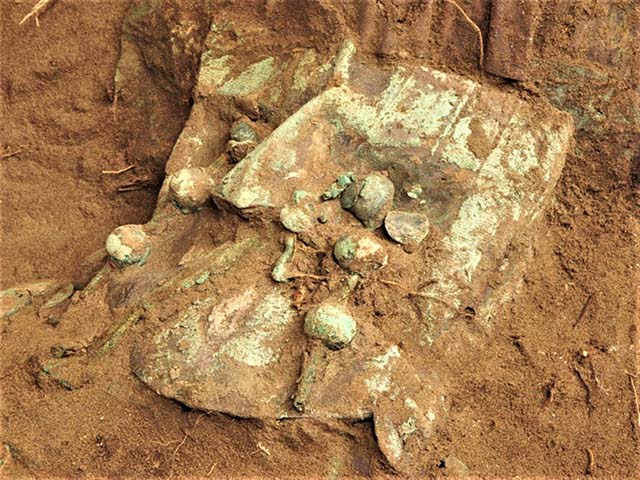
This is the 2nd part of a two-part article. Read part one here.
On the bundle was a necklace made of twenty-one copper discs. The mask and crown gave the appearance of life “as if the deceased was looking at its own second burial ceremony” (Narvaez, 2011). Upon removal of the first mask and crown and opening of the bundle, a second crown appeared, set on the actual skull. Made of a thin sheet of fine gold, it showed the exquisitely stylized scene of a woman seated in profile and resting in the crescent of the Moon. This depiction places the woman in the crescent at the heart of the feminine association with the complex world of the Lambayeque culture and its deity, the Moon. Above all, however, it is the figure of a powerful deified ancestor. Osteological analysis confirmed that the remains were that of a woman 45 to 55 years of age. Her unnatural cranium deformation established that she was a member of the nobility, for body modification underscored a person’s high status. Skeletal analysis established that she lived during the second half of the 13th century, the last period of the Lambayeque culture, before the Chimú conquest.
The priestess “sat” facing east toward the rising of the Moon and the renewal of life, for another day. As Narvaez notes, “she personalized absolute control over the realm of the Moon and its association with the sea from where Ñaimlap came, which underlined her divine status during her lifetime immortalized as a deity beyond life” (2011). Foremost, as Shimada points out, “the funerary rites and rituals performed by living family members served to further reinforce their lineage identity and assert the three-way relationship between the divine, the dead, and the living elite” (2004).
In the funerary bundle and grave, archaeologists recovered over three hundred bracelets, earrings, and other objects made of gold, silver, and burnished copper-gold alloys, in which predominate the image of Ñaymlap, the eponymous founder of the Lambayeque culture. Three important pectorals adorned the remains, one showed the anthropomorphic wave of the ocean, and another displayed the hallucinogenic San Pedro cactus (Echinopsis pachanoi), used in shamanic vision ceremonies. Fine Cajamarca style ceramics, many necklaces made of amber, precious and semi-precious stones, as well as thousands of small beads made of imported seashells such as conus (conidia) and spondylus (spondylea) from Ecuador’s south coast, and sacrificial copper knives (tumi) were also found in the bundle. The body of the priestess was covered with two mantles, one of which had small lunar-shaped copper discs stitched on the fabric, designed as the mythic wave associated with the ocean.
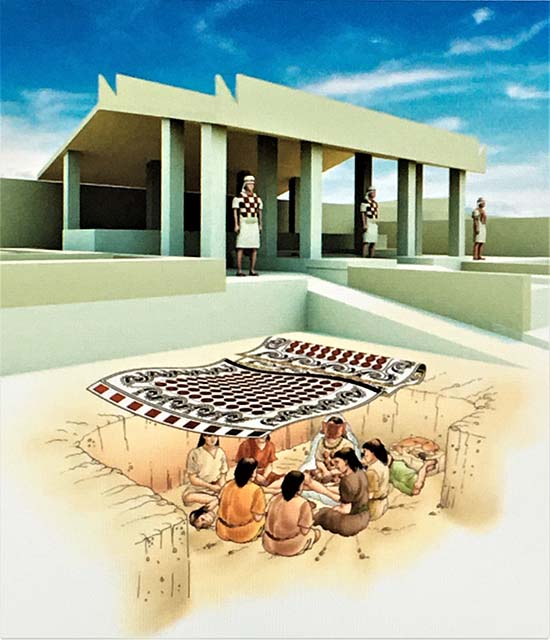
Several bi-metallic gold and silver implements were found, a duality symbolically associated with the Sun as gold and the Moon as silver. Upon removal of the last mantle archaeologists found an article of remarkable artistic quality made of fine laminated gold; it was placed in the priestess left hand, underlining her high status. It is a ceremonial or command scepter, nine inches long, on top of which is a feminine deity found in classic mythological position, together with the ocean wave. The scepter underlines the priestess’ extraordinary political and religious authority.
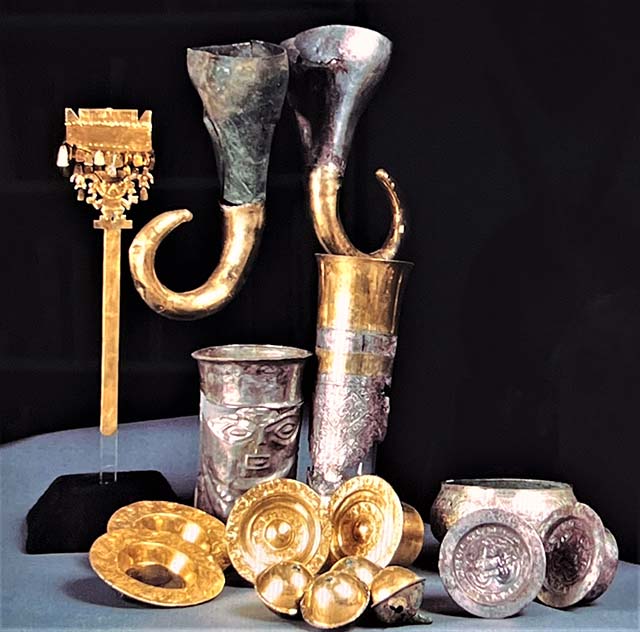
Also buried with the priestess, were eight sacrificed young women, all adorned with small, burnished copper jewelry and carved bone figurines. The body of a twelve-to-fifteen-year-old girl was found near the priestess’ head together with that of a young camelid (llama).
The other seven were between fifteen and twenty years of age. Three were found to the north, one to the east and two to the south, together with the decapitated head of another human, apparently brought from another grave. The gender of the head could not be ascertained for lack of missing skeletal bones but was, in all probability, that of a female. Of note is that in the mouth of woman number five were found thirteen little gold nuggets and a small round silver ingot, probably underlining her rank and special status in the priestess’ retinue. The young women all “sat” in a circle with the fifth facing the priestess. They were sacrificed to serve her in the afterlife.
Another potent symbol shown on the artifacts in the grave is the anthropomorphic ocean wave, which refers to the actual and mythological importance and power of the ocean from where Ñaylamp, the culture’s founder came. This symbol underlines the bounty of life associated with the moon and its powerful influence over the tides. As in all binary beliefs rooted in the field of opposites, it also underscores the ocean’s catastrophic recuring threats, such as those we know as El Niño today. As Shimada points out, “sometimes around 1100AD, the Sicán deity nearly vanished from the iconography of northern Peru. A ubiquitous symbol for nearly 200 years, the deity did not survive a spasm of environmentally and culturally induced disasters that toppled the Middle Sicán polity” (2000).
The artifacts found in the grave and the priestess’ adornments show that she was the all-powerful leader of a large and diverse community spread over a vast territory. Her all-encompassing powers, signaled by the contents of her grave, help us understand the complex structure of the Lambayeque societies that, until recently, were believed to have only been led by men. The priestess was at the apex of a complex political and religious hierarchy encompassing local, regional, and macro-regional levels beyond Chornancap to Cajamarca, La Libertad, and further north, to today’s Ecuador. The women of these cultures were not only highly respected near and far during their lifetime but were also believed to become divine ancestors that secured future harmony and continuity for their people. As Shimada points out, “funerary rites and rituals performed by the living direct descendants helped to further reinforce their lineage, their identity and the three-way relationship between the divine, the dead, and the living elite” (2004). Of note is that the bundle and its content were understood to stand at the border between the mythic and the real history of a person, a family, or a community. The hypothetical face of the Priestess of Chornancap shown here, was created thanks to the expertise of the American forensic anthropologist Dr. Daniel J. Fairbanks in 2012. He used as a model photo made in the late 1800s by Hans Henrich Brüning of women of the Muchik ethnic group living in the Lambayeque valleys.
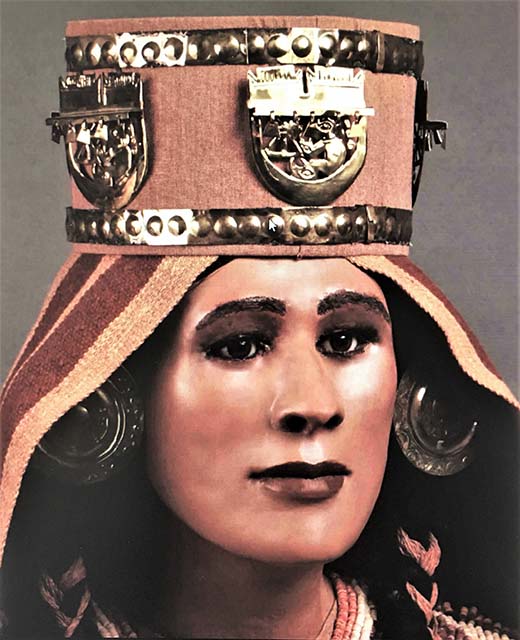
Upon reaching the bottom of the priestess’ grave, the archeologists dug about five feet further down to ascertain that there was nothing left below through eventual water seepage. To their surprise, they found another buried body, that of an adult male, thirty to forty years of age, lying flat on his back on an east-west alignment. He was not wrapped into a bundle, nor were the remains of a coffin found. This burial sequence is unknown elsewhere in Andean America. In the grave were found large and small globular ceramics and metal offerings, as well as copper knives (tumi). However, the most striking find were two groups of ten shells of spondylus bivalve (spondylus princeps), placed on each side of his head, and one shell in each of his hands.
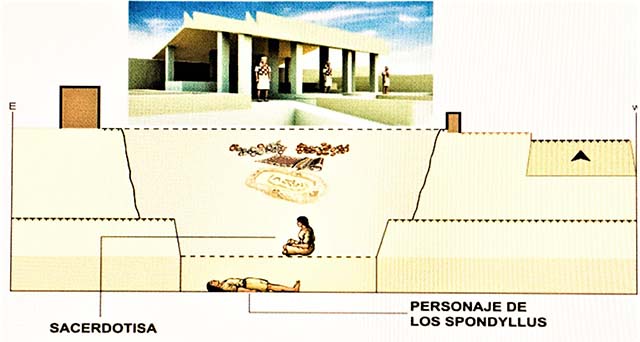
Spondylus were also found in graves at Chotuna, as well as in burials of most of the ancient cultures of the Americas. The spondylus is a bivalve mollusk associated with the Primordial Sea, as the Maya refer to it, and the beginning of time to which all lives return at the end of their days. The fact that this man was buried flat on his back, and the number and placement of spondylus strongly suggest that he might have been a powerful religious man. The question remains, however, as to why the priestess grave was placed above his? The Moche traditionally buried their lords independently of any other nearby, witness the graves at Sipán (Alva, Donan, 1993), San José de Moro (Castillo, 2003), those of Lambayeque at Batán Grande (Shimada, 1994), and other elite tombs on Peru’s north coast. In this case, the superposition of the man’s grave point to an uncertain connection with the priestess, be it family, political, or religious. We may only speculate, for the record is still silent on this point.
The cultural association of the man in the burial was established through symbols found on twenty-eight small copper disks placed on his chest and representing the anthropomorphic wave. The secular and spiritual association with the ocean, upholder of life, was central in the beliefs of the coastal cultures of Peru. As Shimada underlines, “around 1020, a major drought lasting thirty years occurred at Sicán. At the time of the drought, the Sicán deity, Yampalec, closely associated with the ocean and water in general, was at the center of the religion. The long-lasting catastrophic changes in weather (probably triggered by successive El Niño and La Niña events), were thus linked to the deity and its perceived failure to appease nature for the benefit of the people. Religious ceremonies were expected to secure that there would always be an abundance of natural resources to meet the people’s needs.
Furthermore, the elites were believed to be the sanctified mediators between nature, the society at large and the Sicán deity. After thirty years of hardship due to the uncertainty of nature, the temples that were the center of the Middle Sicán religion (900-1100AD), were burned and abandoned between 1050 and 1100. Perhaps the ancestor cult and expansion of power of the elites caused unbearable resentment. Coupled with the drought that weakened agriculture in the area, the tolerance of the common population plummeted, leading to the removal of the political and religious leadership. Further destruction inflicted by El Nino’s floods around 1100 sealed the fate of the society” (Shimada et al, 2004). As Jennings point out, “shaken, people that survive disasters often question their beliefs, create new social groupings and assign culpability to reconstruct their lives,” under these conditions, “new religious ideas and new leaders often emerge that take cultures in new directions” (2008).
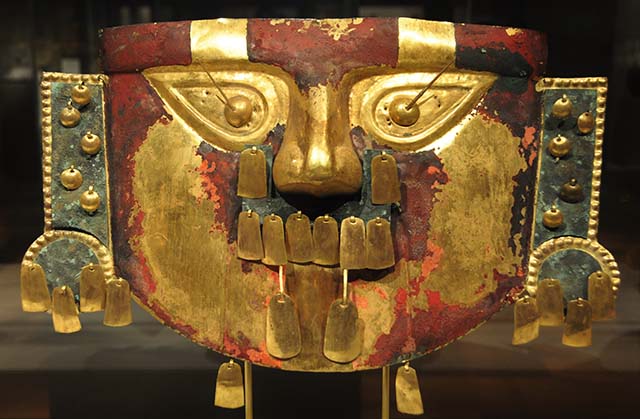
Must be stressed again the perception of life beyond life and the key role of ancestors, for it is found in most ancient and contemporary beliefs and is central to our story. Foremost, ceremonies related to death helped make the deceased socially alive beyond the grave. McAnany reminds us that “the cult to ancestors was integral to the cosmology and traditions of most cultures in the Andean region and is well documented in those of Mesoamerica” (1995). Divinized ancestors served to create cultural heroes and ancestral deities that were, through repetition, grounded in the long-term social memory of the group, as a common cultural and historical heritage. That is why the bundle of past lords as divinized ancestor, were carried through the assembled community at dedicated times, to keep the departed in the social mind, as a reminder of the descendants to social, political, or religious legitimacy.
Peruvian historian Maritza Villavicencio remarks that “the graves of women leaders such as those of the Moche priestesses of San José de Moro, or the elite Wari women mausoleum of El Castillo de Huarney, were sacred centers of religious and political power, as was the Huaca Pucllana in Lima, and the acllahuasi Inca. The Priestess of Chornancap was a secular and religious leader whose authority encompassed far-reaching territories” (2014). Like the Priestess Mochica of San José de Moro (Castillo, 2003), and later the capullanas Inca, the Priestess of Chornancap’s powers were supreme. She did not owe nor share her determination nor socio-political and religious powers with anyone, be it her father, consort, or brother. Unknown is whether she gave birth to an heir. And if the transmission of power at her death followed an exclusive matrilineal-feminine line of descent, could it have shifted to a son in the absence of a female descendant? The record is still silent on this point, so we may never know.
Photo and Art credits:
The Priestess’ Mortuary Mask ©andina.pe
The Priestess’ Companions ©arqueologiadelperu.com
Bi-metals Implements and Scepter ©arqueologiadelperu.com
The Priestess of Chornancap ©andina.pe
Moche Ceremonial Mask ©cynic.org.uk
References Cited and Further Reading:
Izumi Shimada et al., 2004 – An integral Analisis of Pre-Hispanic Mortuary Practices
Christopher B. Donnan, 2011 – Chotuna and Chornancap
Izumi Shimada, 1995 – Cultura Sicán
Carlos Wester La Torre, 2015 – Chornancap : Historia, Genero y Ancestralidad en la Cultura Lambayeque
Justin Jennings, 2008 – Catastrophe, Revitalization and Religious Change on the Prehispanic North Coast of Peru
Izumi Shimada et al., 2010 – Pampa Grande and the Mochica Culture
Carlos Wester La Torre, 2016 – Libro Chotuna-Chornancap
Jeffrey Quilter, 2001 – Moche Politics, Religion, and Warfare
Carlos Wester La Torre, 2018 – Personajes de Elite en Chornancap
Luis Jaime Castillo B., et al., 2005 – La Sacerdotisa de San José de Moro
Paul A. Kosok, 1959 – Life, Land and Water in Ancient Peru
Patricia A. McAnany, 1995 – Living with the Ancestors
Mircea Eliade, 1954 – Le Mythe de l’Eternel Retour
Bloch & J. Parry, 1982 – Death and the Regeneration of Life
About the author:
Freelance writer, researcher and photographer, Georges Fery (georgefery.com) addresses topics, from history, culture, and beliefs to daily living of ancient and today’s communities of the Americas. His articles are published online at travelthruhistory.com, ancient-origins.net and popular-archaeology.com, as well as in the quarterly magazine Ancient American (ancientamerican.com), and in the U.K. at mexicolore.co.uk.
The author is a fellow of the Institute of Maya Studies instituteofmayastudies.org, Miami, FL and The Royal Geographical Society, London, U.K. rgs.org. As well as member in good standing of the Maya Exploration Center, Austin, TX mayaexploration.org, the Archaeological Institute of America, Boston, MA archaeological.org, the National Museum of the American Indian, Washington, DC. americanindian.si.edu, and the NFAA – Non-Fiction Authors Association nonfictionauthrosassociation.com.
Contact: Georges Fery – 5200 Keller Springs Road, Apt. 1511, Dallas, Texas 75248, (786) 501 9692 –gfery.43@gmail.com and www.georgefery.com


Leave a Reply
You must be logged in to post a comment.